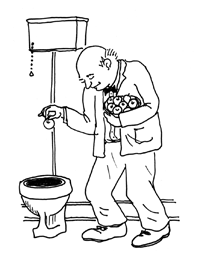STRANGE BUT TRUE- Toilet test: How Thomas Crapper did his business

DRAWING BY DEBORAH DERR McCLINTOCK
Q. Don't laugh. It was hard work developing the flush toilet. For instance, careful thought had to go into what test materials to use in simulated flushings, for certainly the real stuff was inadvisable. What did the developer use? –M. Clean
A. As recounted in the book Flushed with Pride: The Story of Thomas Crapper, one of his early "super-flushes" successfully cleared away 10 apples averaging 1 3/4 inch in diameter, 3 air vessels, a pan coated with plumber's "Smudge" and four pieces of paper adhering to the soiled surface.
Q. Why are people marrying so much later these days? How might an economist explain this?–L. Minelli
A. Think in terms of "opportunity costs," or what must be sacrificed to pursue a certain path, says Robert Frank in "The Economic Naturalist." These costs have been increasing for those who choose to marry young. As a result, marriages worldwide have been pragmatically delayed. For example, in the U.S. in 1960, the average age at first marriage was 22.8 for men, 20.3 for women; by 2004 the figures were 27.4 and 25.8 (28.7 and 26.9 in Australia).
A key reason is that the amount of education needed to get a good job has increased. But early marriage makes pursuing higher education tougher, especially for young parents. And to the extent that people nowadays hope to marry someone successful, the information required to predict this is not available as early as it used to be.
Also, early marriage traditionally seemed to promise winning an attractive partner before all the desirable ones were claimed. But with higher incomes and education levels and greater mobility has come access to a steadily growing pool of potential marriage partners. Even the benefits of having kids while young and healthy have diminished with improvements in medicine and longevity. In short, the premium on marrying young has shrunk, putting those wedding bells on hold, at least for a while.
Q. Can you figure the common denominator for the following: your baby's cute face, the cinematic extraterrestrial creature E.T., Cabbage Patch dolls, and the lovable cartoon character Mickey Mouse?–A. Geddes
A. Probably the best answer is "neoteny," the retention of juvenile features such as large round heads relative to body size, adult-sized eyes, round cheeks, a flat nose, short arms and relatively little body hair, says David Bjorklund in "Why Youth Is Not Wasted on the Young." These types of characteristics are evolutionarily endearing to adults, whose helpless babies may keep them awake all night but are so cute it's hard not to love them anyway. Neoteny is shared by the young of many species, including dogs whose faces are deliberately bred for this to help ensure their adoption and well-being.
Retaining neotenous features longer than other species, we big-brained humans enjoy a protracted childhood that is key to learning and to the development of our complex, sophisticated culture. "Science fiction writers and UFOlogists seem to be aware of this evolutionary trend, typically describing futuristic humans and visiting space aliens as short, hairless creatures with large heads and big eyes."
Q. Have you ever served up "cold slaw" or considered joining the "Peace Core" or been "boggled down" trying to explain things in "lame man's terms"? Don't worry, it's not incipient "old-timer's" disease.–G.W. Bush
A. Use one of these phrases and you've just "laid an eggcorn," derived from a misspelling of "acorn." These colorful English language errors can often be "more satisfying or poetic than the correct word or expression," says "New Scientist" magazine. Cole slaw is indisputably served cold, a layman is certainly lame compared to an expert and Alzheimer's disease does afflict oldtimers.
What distinguishes these mistakes from ordinary malapropisms–words that are unintentionally confused with others that sound similar–is the creativity and logic behind them. Dictionaries are loaded with words reshaped by this sort of popular use: "straight-laced" and "just desserts," for example, are now used more often than "strait-laced" and "just deserts." Will eggcorns continue to hatch? This is a moot point (or is that mute?). Yet certainly anyone waiting with "baited" (bated) breath for "whole scale" (wholesale) changes may need to wait a while.
~
Send strange questions to brothers Bill and Rich at [email protected].
#